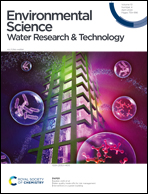Removal mechanisms of illicit and psychoactive drugs in different wastewater treatment processes†
Abstract
Illicit and psychoactive drugs can reach wastewater treatment plants (WWTPs) after body elimination or direct disposal of drugs into sewers. Here, the concentrations of nineteen illicit and psychoactive drugs, including stimulants, opioids, hallucinogens, appetite suppressants, and antianxiety, antidepressant, and antipsychotic drugs, were analysed in raw and treated wastewater from three different WWTPs, and removal efficiencies were calculated. Twelve drugs were found at quantifiable concentrations in raw wastewater from at least one WWTP. Codeine was the drug with the highest mass concentration, while methamphetamine was the stimulant with the highest mass concentration in raw wastewater. None of the selected antianxiety or antipsychotic drugs were detected in any samples. Although amphetamine, methamphetamine, morphine, cocaine, and codeine were removed (≥75%) in all WWTPs, other drugs (tramadol, phentermine, oxycodone, citalopram, venlafaxine, and ketamine) had low removal efficiencies, indicating incomplete elimination during wastewater treatment. High correlations between drug removal during wastewater treatment and the individual physicobiochemical characteristics of the drugs, as well as the WWTP operational parameters promoting biodegradation, were observed, contributing to new knowledge on the mechanisms of drug removal in WWT. The membrane bioreactor process was observed to be more efficient than the oxidation ditch or the conventional activated sludge WWTPs for removal of amphetamine, methamphetamine, morphine, tramadol, codeine, citalopram, venlafaxine, and ketamine. The membrane bioreactor process should therefore be considered as a key option when removal of illicit and psychoactive drugs is important. Codeine and venlafaxine were identified as posing a potential risk to the environment upon wastewater discharge.



 Please wait while we load your content...
Please wait while we load your content...